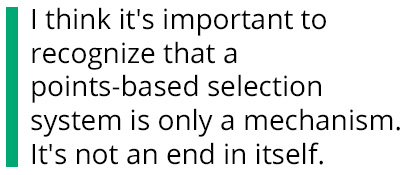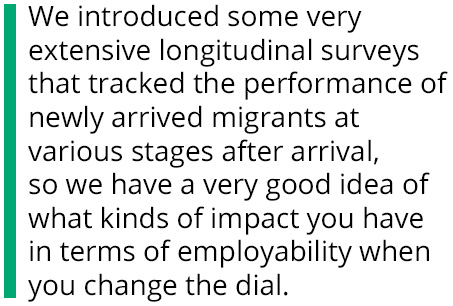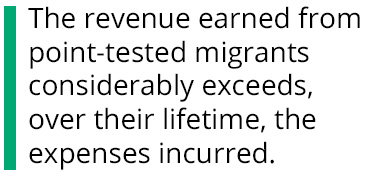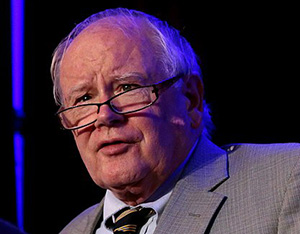 As Deputy Secretary of the Australia Department of Immigration, Abul Rizvi was responsible for development and implementation of that country’s point system for over 10 years and was involved in its earlier development for another 10. With an eye toward exploring the possibility of a similar system in the U.S., Ideaspace talked with Dr. Rizvi about what he learned through his experiences at the Australia Department of Immigration and elicited his opinion of the point system now that he has had time to reflect on its implementation and evolution.
As Deputy Secretary of the Australia Department of Immigration, Abul Rizvi was responsible for development and implementation of that country’s point system for over 10 years and was involved in its earlier development for another 10. With an eye toward exploring the possibility of a similar system in the U.S., Ideaspace talked with Dr. Rizvi about what he learned through his experiences at the Australia Department of Immigration and elicited his opinion of the point system now that he has had time to reflect on its implementation and evolution.
Below, our full interview with Rizvi, which has been lightly edited for clarity.
Ideaspace: When we have debates here in the U.S. about the possibility of a points-based system, it’s always Australia and Canada that are referenced. From all those years of experience and implementation, how would you describe possible pitfalls and also major benefits of such a system?
 AR: I think it’s important to recognize that a points-based selection system is only a mechanism. It’s not an end in itself. Too often, when governments such as the United States talk about a points-based system, it almost sounds as if it’s an end in itself. What is never clear when they talk about a points-based system, what’s the objective that you’re trying to achieve? If you can’t articulate clearly what you’re trying to achieve, whether you use a points-based system or not is neither here nor there.
AR: I think it’s important to recognize that a points-based selection system is only a mechanism. It’s not an end in itself. Too often, when governments such as the United States talk about a points-based system, it almost sounds as if it’s an end in itself. What is never clear when they talk about a points-based system, what’s the objective that you’re trying to achieve? If you can’t articulate clearly what you’re trying to achieve, whether you use a points-based system or not is neither here nor there.
In Australia, the points-based system, which has a history of nearly 40 years, was introduced for two predominant reasons. Firstly, Australia was interested in growing the population through skilled migration beyond the outcome that could be achieved through employer sponsored migration – and that was made clear. The best way to do so was with a points-based system because it gave you objective criteria against which you could assess applicants and come to a conclusion that would enable a strong labour market outcome that would deliver both economic and budget benefits.
Now, whether that is still the objective of either the Australian government or the United States government, I don’t know. Is growing the population still an objective? That would be the first question I would ask the respective governments. The second question I would ask, and this is relevant to the Australian situation as well as the US, relates to aging. From about the late 1990s concerns about an aging population were becoming substantial and there was a view that immigration could successfully be used to slow the rate at which the population aged. The points-based system was useful in that sense. Once again, it grew the population, but also reduced the rate of aging. That was an important objective at that time. Whether or not that is still an objective for Australia is another question.
The current government has reduced the size of the migration program. The points-based system only applies to a portion of the skill stream. The points-based system portion of the skill stream is the most discretionary portion. It’s the portion that you can grow if you wish to. It’s the portion you can shrink if you wish to most easily because there are no stakeholders involved. Well, no direct stakeholders involved.
An employer-sponsored portion of the skill stream has remained in place. The business skills portion of the skill stream has remained in place. And another portion which we have in common with Canada, which is where state governments sponsor people for migration, has also remained in place. But the points-based selection portion has shrunk; where the points is the only mechanism used, that portion is now much smaller.
I: In your estimation, that shrinkage is due to a shift in the government’s objectives?
AR: I think so. I think the government hasn’t talked about slowing the rate of aging in the population in recent years. I don’t know what the reason is. Occasionally, the Treasury Department here, and the Reserve Bank, the equivalent of your Fed Reserve, remind the government of the problems of an aging population. But to some degree, the current government has taken its eye off the ball on that, focused on other things. Really, the reason the points-based system became so strong during the early 2000s was about aging. It was about slowing the rate of aging. Australia did indeed slow the rate of aging. In the late 1990s, we expected by 2020 to have a median age of about 40, 41. It turned out that we were able to slow that down so that our median age by 2020 was only around 37. Now, three or four years may not sound a lot, but from an economic perspective, it makes a very big difference.
I: That’s interesting. The point is well taken that the point system is a vehicle, and you have to know your objectives. At the point that the system was being developed, the Australian government’s objective was to grow the population, but more precisely, to grow it in a youthful way, right?
AR: Correct.
I: And so you could create a system that supported that. How finely do you think that a government can dial down in terms of its objectives? Grow the population is a very broad objective, growing it in a youthful way is a little bit more precise. How precise do you think that those objectives could get with a point system?
AR: Bureaucrats have an unending ability to fine-tune point systems. For example, another dimension of the point system that we used was to have a minimum level of English language ability. Secondly, you had to have a minimum level of recognized skill. Skill had to be tested by the appropriate skills assessing body such as for doctors, the relevant doctor body, and for dentists, engineers, etc. Then, you could fine-tune it even further in terms of age, so you could target the precise age group that you wanted. All of it with the objective of maximizing the employment status of the migrants as quickly as possible. The criteria for success was how quickly did that person get a well-paying job using their skill after arrival.
I: Was there a follow-up policy in terms of that assessment once someone arrived in the country?
AR: Yes, absolutely. From the early 1990s, we introduced some very extensive longitudinal surveys that tracked the performance of newly arrived migrants at various stages after arrival, so we have a very good idea of what kinds of impact you have in terms of employability when you change the dial.
I: That sort of longitudinal survey work, did it come with consequences? Were there possibilities where someone could have a visa revoked? Or was it more for the government’s own understanding?
AR: No, the survey was for fine-tuning government policy. There are separate reasons for canceling people’s visas, but the survey was not one of them.

I: Looking back on the work you did and perhaps putting aside the Australian government’s current shrinkage of the system, what do you think of it? Would you endorse a point system for other countries?
AR: It is a useful mechanism, undoubtedly, but it’s not a useful mechanism if you don’t know what your objective is. America is in a slightly different position to most developed countries in the world in this regard. America’s population is comparatively young amongst developed nations. America’s population is still growing at a reasonable clip. Leave aside COVID, it’s still growing at a reasonable clip compared to the vast majority of developed nations. America’s population is unlikely to peak until well into the second half of this century unless, of course, something dramatic happens with its fertility rate, and America’s fertility rate has been falling. But at the moment, I think it’s still over 1.7, which for a developed nation is comparatively high. But if it were to fall to levels such as those of Japan or China or South Korea or Europe, I think then you would be facing a very different set of demographic circumstances. I think going back to the population situation, you really do need to have an understanding of where your population is heading and where you want it to head.
I: The population is one thing, and also the labor market is another, right?
AR: Correct.
I: U.S. economists say that we have a gap between what the labor market needs and what it’s getting from the native population. In your estimation would filling such a gap be an appropriate objective for a point system?
AR: Absolutely, yes. A secondary objective that the Australian government had with using the point system was to fill labor market gaps that it could see were coming down the path. For example, with an aging population, it is inevitable that you will have a shortage in the health workforce. Not just doctors and nurses, but probably also care workers for the aged and so on. It’s always been a challenge for countries such as Australia to be able to train enough doctors, enough nurses, et cetera, for the rate at which we were aging. As a result, the health workforce was a priority target for the point system from around 2000. The point system can be tailored to target particular sectors of the economy, particular occupations. We’ve always, for example, given extra points for nurses.
The other significant thing that Australia did was to target overseas students with bonus points available for people who have studied in Australia. If you combine that with English language, age, youthfulness, and a targeted occupation, that comes together in terms of a quite symbiotic policy framework of growing, not just the economy, not just dealing with labor shortages, not just slowing the rate of population aging, but also growing a substantial export industry. I mean, I know overseas students are a big deal in the United States, but per capita, they’re an even bigger deal in Australia.
I: It speaks to the fact that if someone has pursued an education in the country, it tells you something about their interaction with the culture already, and their familiarity with the culture.
AR: Correct. Most overseas students already have experience of the Australian labor market which gives them a substantial advantage.
I: Something I hear from people in the U.S., particularly people on the policy side, is that big employers, the private sector, say to the government, “Look, stay out of our business. We know best how to find the best nurses. We know best how to find the best doctors or the healthcare workers. Don’t tell us how to find them. Why is the government drawing up a map for identifying the best possible nurses or so forth?” What do you say to that? How did that work out in Australia in terms of private sector cooperating with the government? How were those standards arrived at?
AR: In terms of standards, that’s got to be dealt with by an independent body. You can’t have employers determine standards of who’s a doctor and who’s a nurse, etc. I assume that’s the case in the United States as well. But in terms of overseas recruitment, the employers are absolutely correct, as long as they meet minimum standards and do not indulge in exploitation, etc. So you’ve got to protect the worker. It is the case that employers are best placed to select the people they want to recruit from overseas. Employer-sponsored migration in Australia has traditionally been of a much higher priority than points-system migration. But the number of people the employers were able to recruit themselves was not meeting the numbers or the size of the program the government wanted to deliver. The points-tested category was effectively supplementation of the labor force, targeting particular areas where shortages were anticipated. In Australia, employers don’t object to the points-system migration. They’re quite comfortable with it.
I: Why do they have to be siloed as systems? Employer recruitment, point system, why can’t there be a point system that is the foundational system that employer recruitment fits within?
AR: You could do that. It does make the system more complex. What you don’t want is a bureaucratic system, beyond minimum occupational standards, prevention of exploitation and undermining the employment opportunities of locals, to be overruling an employer.
If the employer says, “I want X person for this job,” and that person has precisely the right skills in, let’s say some sort of IT system or something like that, that’s very, very precise in terms of what the employer needs. There’s no way the point system can be that precise to be able to pick that person out. That’s where you need the employer’s intelligence and knowledge, and what you don’t want is a bureaucratic system overruling the detailed knowledge of an employer in terms of what they need.
I: The economy is the driver for most nation states trying to develop their objectives with immigration. I was talking to a professor at Cornell University who developed a small model for a point system. The point system model gave points for sex, if you were a woman, because in the U.S., traditionally everything is slanted towards European men. Can you speak to the capacity of a point system as a vehicle for incorporating cultural considerations and if that becomes a slippery slope for you.
AR: Certainly, we’ve never thought of incorporating gender into the point system. We’ve never seen a necessity for it for two reasons. Firstly, the people who migrate to Australia migrate as a family unit so their spouse comes with them. So we felt there was no need to deal with gender. If you do migrate, often because you’re migrating at the age of 20 or early 30s, you’re probably going to get married fairly soon anyway. We never thought of incorporating gender. We did incorporate, and have incorporated for over 30 years, points for proficiency in a second language. You had to be more than just being able to talk the language, you had to be of a minimum standard in terms of proficiency to get points for language. We’ve never incorporated any points for country of origin or for race, color, nationality, etc. I mean that’s just taboo.
I: In broad strokes there is consensus in the U.S. on the possibility of a point system, but it all falls apart when you dial down on the specifics. I wonder if there are any other identifiers that Australia used, or that you’re aware of, that could help assuage fears that people have, that are looking for a more humanitarian-oriented or compassionate system?
 AR: Really, the point system was not designed around humanitarian issues. We’ve never gone down that path. We’ve had a separate humanitarian program. We recruit our offshore refugees directly from overseas refugee camps and we work with the UNHCR in doing that. Now, at times our behavior in that regard has not been exemplary, at times we’ve done reasonably well. That tends to boil down more to policy intent than to anything else. I really don’t think a point system works in a humanitarian space. Once you’ve been recognized as a refugee, you’ve been recognized as a refugee. Within that, Australia has set priorities. For example, women at risk, in particular, are targeted through the humanitarian program. Foreign policy objectives are often also relevant in that we tend to target countries where there’s a foreign policy element of trying to help. For example, Syria was a priority for a period during the Syrian crisis. Similarly, the Balkans was a priority during the 1990s. Rwanda was a priority during the early 2000s. But I don’t think humanitarian migration is suited to a point system. It’s too inhumane.
AR: Really, the point system was not designed around humanitarian issues. We’ve never gone down that path. We’ve had a separate humanitarian program. We recruit our offshore refugees directly from overseas refugee camps and we work with the UNHCR in doing that. Now, at times our behavior in that regard has not been exemplary, at times we’ve done reasonably well. That tends to boil down more to policy intent than to anything else. I really don’t think a point system works in a humanitarian space. Once you’ve been recognized as a refugee, you’ve been recognized as a refugee. Within that, Australia has set priorities. For example, women at risk, in particular, are targeted through the humanitarian program. Foreign policy objectives are often also relevant in that we tend to target countries where there’s a foreign policy element of trying to help. For example, Syria was a priority for a period during the Syrian crisis. Similarly, the Balkans was a priority during the 1990s. Rwanda was a priority during the early 2000s. But I don’t think humanitarian migration is suited to a point system. It’s too inhumane.
I: Was there a fee associated with the point system?
AR: There’s a fee. There are pre-application fees and there are fees associated with the application itself. For example, before you could apply, you had to get your skills tested and you had to go to the relevant skills testing body. That body charges whatever fee it charged. If you had to get your English tested, you had to go to an accredited English testing body, and that body would charge a fee. So there are substantial costs associated with the application process. The administration of the system was more than fully cost recovered. In fact, the fees that apply operate under tax legislation. The government actually makes a profit from it. The fees mostly exceed the cost of processing, but that’s only a small dimension of the cost, of course. The bigger issue is what is the long-term impact in terms on budget revenue and budget expenses? A lot of work has been done in Australia on that. The points-tested category comes out as the second or third highest contributing category in terms of a positive budget outcome. The revenue earned from point-tested migrants considerably exceeds, over their lifetime, the expenses incurred.
I: Was that part of the calculus on the part of the government in terms of viewing the point system as a revenue generator or did that just happen as a matter of course over time?
AR: When post-war migration started under Arthur Calwell in 1945, he gave a speech to parliament and he said, “Migrants must not be a charge on the Commonwealth’s budget. It must not be a net charge.” So, that was a principle long established. Now, it was understood that humanitarian migrants would be a net charge. We’ve always accepted that. But skill stream migrants cannot be a net charge to the budget, they must be a net positive to the budget. Otherwise, you wouldn’t do it.
One substantial difference between our arrangements, as I understand the U.S. arrangement, is that the executive government in Australia has far greater flexibility and discretion over the size of immigration compared to the executive in the United States. Is that a reasonable statement?
I: It is, it is. This is one of the big barriers in the U.S. to making this happen.
AR: Yeah, I mean I would be uncomfortable giving someone like Mr. Trump had discretion over the size of immigration to the United States. On the other hand, if it was a president with a reasonable level of understanding of the issues, I’d be quite relaxed about it.
I: I think that one of the things that gets floated but it’s complicated and hard to achieve, is the possibility of appointing an independent administrative body, a third party, a panel of some kind. Could there be a body like that developed so its job is detached from political involvement? Their job would be to constantly update a point system, constantly monitor it.
AR: If politicians could be persuaded to give up powers, which politicians rarely want to, that would be a very sensible pathway to go down.
I: I think it actually has a lot of promise. Out of the gate, it feels a little dramatic for a lot of people, but bigger mountains have moved, I suppose.
AR: Yes. I mean, surely in the United States, the system at the moment, the immigration system, is not really delivering for many people very well. I’m sorry to say this, you couldn’t be managing it even worse, could you?
I: But I have to say, the average American citizen, unless they have skin in the game, their concerns stay with their own economic plight, and then therefore you see too many opportunities to pit immigrants against citizens erroneously. We’ve done this for hundreds of years and we’re still doing it. But that’s where the energy goes in the U.S.
AR: For the greatest immigrant nation on the planet, that is surprising, isn’t it?
I: I mean we have letters signed by 1,500 economists saying that immigration benefits the country, but it just doesn’t do the trick in terms of penetrating conversations people have in cafes and in churches and so forth. It’s a real wonder about how you penetrate that here.
AR: Yes, it does sound hard.
I: How was that a factor there in Australia just in terms of public sentiment and public education and communication with the public in terms of the benefits of the points system? Was there a whole campaign undertaken there? Was that a big struggle?
AR: Really, the point system we started in the ’80s was accepted quite readily by the Australian public. It wasn’t particularly controversial. In fact, most Australians wouldn’t have even noticed we introduced it. Because we had our post-war migration program, which in capita terms, even bigger than the one in the United States. People had become accustomed to immigration for a long time. Immigration really only became a political issue with the stopping of the [refugee-laden] tanker and then the obvious protesting. That’s when it became seriously political.
I: That’s where it taps into people’s fears about immigrants becoming charges, right? And the cost to the state.
AR: Yes. Although interestingly, the argument the government put was we stopped these boat arrivals so that we could help those that are most in need and who aren’t jumping the queue.
In Australia, there’s this new notion that has sort of caught on to the Australian psyche. Everyone should queue properly. We seem to be even more obsessed with queues than the Brits.
I: That is absolutely the U.S. frame of mind too. Of course, we say lines, but, “Get in line.” This is what everyone says. This is the cliché that I’ve heard 1,000 times, and it really became clear to me at one point that most Americans, their idea of immigration comes from Ellis Island at the beginning of the 20th century, when migrants came by ships, and they literally waited in queues. I don’t think people understand that’s really not how immigration works anymore. Twenty years can go by, in some cases today, while people wait for their visas to come through.
The other complication is we have, as you know, this inverted math where so much of our immigration is family-based, much more so than other countries. That’s really difficult because it gets very emotional very quickly in terms of looking for ways to perhaps amend that. I think there’s will on both sides of the aisle to say, “Okay. Well, maybe we can reduce it to nuclear family, to children and to partners and so forth.” But it’s tricky.
AR: The point system in Australia was used very effectively to reduce family migration.
I: How did that happen?
 AR: We’re really talking about parents, brothers, sisters, aunts, uncles, nieces — not spouses and dependent children.
AR: We’re really talking about parents, brothers, sisters, aunts, uncles, nieces — not spouses and dependent children.
So let’s put spouses and dependent children to one side. They’ve always remained a priority and I can’t imagine any government not keeping them as a priority. But what we did say, “If you are applying for entry to Australia as a brother or sister or uncle or aunt, etc., you have to apply through a points test. You’ll get points for being a brother or sister, etc., but you will also be assessed in terms of age, English language ability, skill, etc. If you don’t meet the pass mark, then you don’t get in.” That dramatically reduced the level of family migration to Australia.
In fact, I was the poor public servant who had to implement that policy.
I: Well, then good, you’re the perfect person to answer my next question. What kind of pushback was there for that? Because, again, I would imagine that would ruffle all kinds of feathers.
AR: It did. There was extensive debate in the Parliament on that because the government tried to push down that path a little further than I think was actually good policy. What happened was in Parliament, the worst aspects of the government’s proposal were not backed, but the rest of it got through, which effectively meant in terms of brothers and sisters, etc., we dramatically reduced the numbers. It was the point system that did that.
Read More:


Strategic Inquiry No. 2



